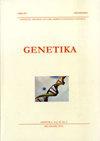Assessment of efficiency of breeding methods using molecular markers in soybean
4区 农林科学
Q3 Agricultural and Biological Sciences
引用次数: 0
Abstract
Four breeding methods viz. pedigree method (PM), single pod descent (SPD), single pod descent with selection (SPDS) and bulk method (BM) were compared for maintaining variability in the population in advanced generations using simple sequence repeats (SSR) markers. The F4:7 lines advanced through different breeding methods from six different crosses were evaluated for number of unique lines retained in each method at a similarity coefficient ? 0.875. Eighteen polymorphic SSR markers were used for estimating similarity coefficient between lines within a breeding method in each cross. In all the crosses, SPD method was the best method in producing unique lines with a range from 42.9 to 100 per cent. SPD method had also the least number of lines pairing with two or more lines. PM and BM had the least number of unique lines in three crosses each and also maximum proportion of lines produced by these two methods were paired with four or more lines. Thus, SPD method was the most efficient among these four methods in retaining the variability in a population, but the breeder has to make a choice between high variability and comparative harvest and seed processing efficiencies to select the most suitable breeding method.大豆分子标记育种方法的有效性评价
利用SSR标记,比较了家系法(PM)、单荚下降法(SPD)、单荚下降选择法(SPDS)和群体法(BM) 4种育种方法对高代群体保持变异的效果。对6个不同杂交组合采用不同育种方法获得的F4:7系,以相似系数?0.875. 利用18个多态SSR标记对每个杂交在同一育种方法下的系间相似性系数进行估算。在所有杂交组合中,SPD方法的单倍率为42.9% ~ 100%,SPD方法的单倍率也最低。PM和BM分别在3个杂交中获得的唯一株系数最少,且两种杂交方法产生的株系配对4个或4个以上株系的比例最大。因此,在这四种方法中,SPD方法在保持种群变异方面是最有效的,但育种者必须在高变异和比较收获和种子加工效率之间做出选择,以选择最合适的育种方法。
本文章由计算机程序翻译,如有差异,请以英文原文为准。
求助全文
约1分钟内获得全文
求助全文
来源期刊

Genetika-Belgrade
AGRONOMY-GENETICS & HEREDITY
CiteScore
1.80
自引率
0.00%
发文量
1
审稿时长
6-12 weeks
期刊介绍:
The GENETIKA is dedicated to genetic studies of all organisms including genetics of microorganisms, plant genetics, animal genetics, human genetics, molecular genetics, genomics, functional genomics, plant and animal breeding, population and evolutionary genetics, mutagenesis and genotoxicology and biotechnology.
 求助内容:
求助内容: 应助结果提醒方式:
应助结果提醒方式:


